
Every person is unique!
Our experienced team will be happy to advise you in detail and free of charge on all matters relating to your health. Book your consultation appointment now:
Vital mushrooms: Valuable natural support for Lyme disease
05 July 2022
Dr. rer.
med. Dorothee Bös
Especially during the warm season, ticks are not only a perpetual nuisance, but also a permanent health threat. After all, they can transmit serious diseases such as Lyme disease.
Even if the diagnosis is often difficult: with the medicinal or vital mushrooms we have a valuable therapeutic option from naturopathy, because they can effectively support those affected even in chronic courses of the disease.
What is Lyme disease?
Tick-borne diseases include, in particular, Lyme disease, which is transmitted by the small bloodsuckers through bacteria from the Borrelia burgdorferi species group. It is also called Lyme borreliosis or Lyme disease. It is a so-called multi-organ disease that can vary in severity and often progresses in episodes. In addition to the acute disease, there is also a chronic form.
Progressions and symptoms
Especially in the chronic courses, both diagnosis and therapy can be very difficult. Sometimes a detective’s intuition is required, as the symptoms often overlap with those of other diseases, especially in the later stages of the disease. There is also a connection with the triggering Borrelia species. Depending on the symptoms then manifest themselves more in the joints, the nervous system or the skin.
In addition, there are still cases with very unspecific symptoms. These include, for example, chronic headaches, lack of concentration or symptoms of exhaustion. It is therefore always important to exclude other diseases. For example, osteoarthritis, arthritis, rheumatism, neurological diseases such as multiple sclerosis, the consequences of a stroke or ALS (amyotrophic lateral sclerosis), as well as sleep disorders, depression or dementia.
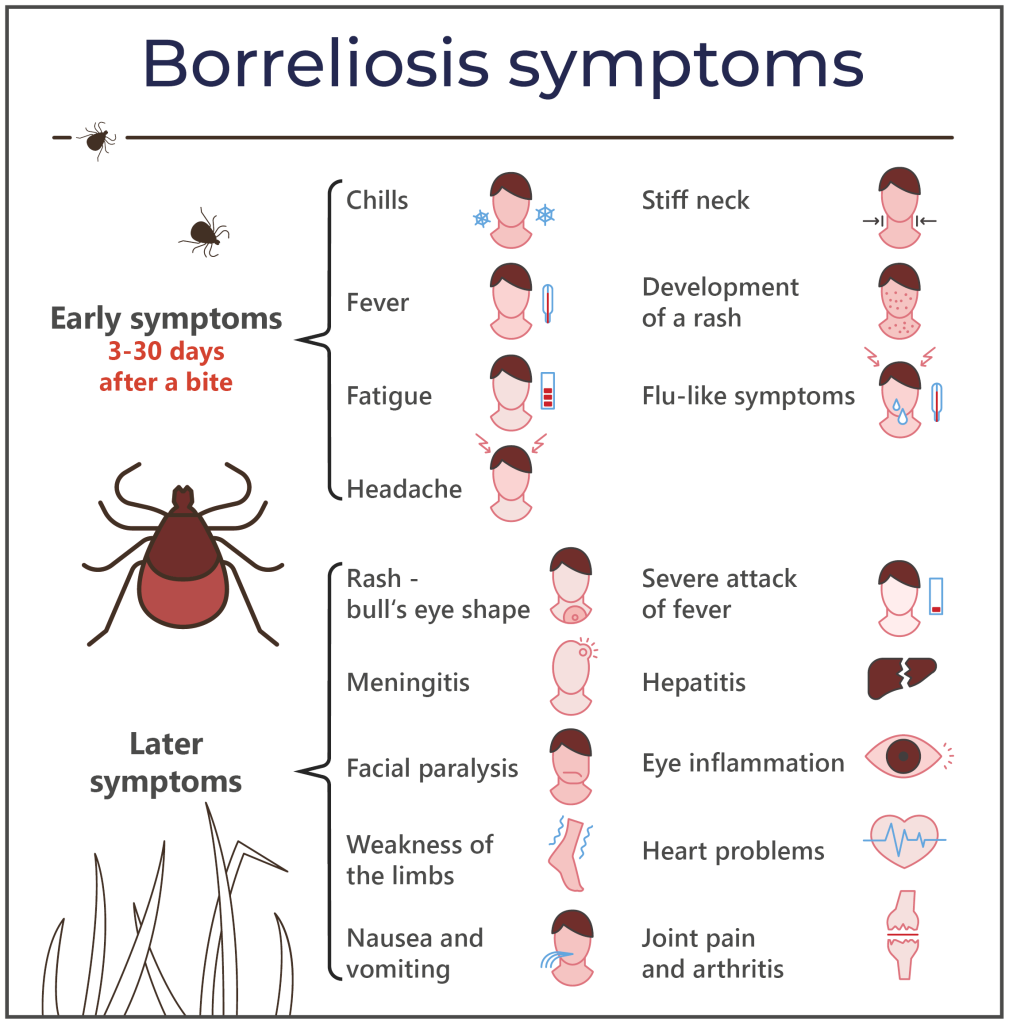
Transmission
Lyme disease is the most common tick-borne disease in humans, both in Europe and the United States. The carrier is almost always the “common wood tick” from the tick family. In rare cases, however, mosquitoes, fleas and horseflies can also be behind it.
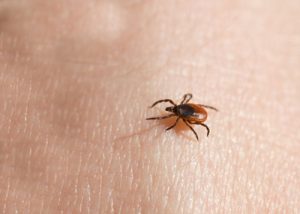 High season for tick bites is summer, although the culprits are already active at an ambient temperature of 5 – 7 °C. Many people are convinced that they can only be infested by ticks on hikes or walks in the forest. But this is a misconception, because it is much more common to catch a tick bite in one’s own garden, in the park or in the home (from ticks that have fallen off pets).
High season for tick bites is summer, although the culprits are already active at an ambient temperature of 5 – 7 °C. Many people are convinced that they can only be infested by ticks on hikes or walks in the forest. But this is a misconception, because it is much more common to catch a tick bite in one’s own garden, in the park or in the home (from ticks that have fallen off pets).
The risk of infection after a bite is high overall, as up to 30 percent of ticks in our country are infected with the bacterium Borrelia burgdorferi. However, infection with the pathogens usually does not occur in the first few hours. The reason for this is that during the sucking process, the Borrelia bacteria only gradually migrate from the tick’s intestine into its salivary glands before they are then transmitted.
Prevention
 Some protection is already provided by fairly simple measures. Ticks are not particularly good climbers and usually only lurk at a height of 30 to 60 cm for possible victims. Therefore, it is convenient to wear long tight-fitting clothes and pull the socks over the trouser legs. Light-colored clothing is preferable, as it is easy to see the ticks on it. Some essential oils, such as lavender, are also said to have deterrent potential against the nasty bloodsuckers. Of course, it is especially important to thoroughly check yourself, your children and your pets for any infestation immediately after spending time outdoors. Once a tick has been found, it should be removed as quickly as possible, but carefully. The best way to do this is with a special tick pliers or tick card. Subsequently, then please disinfect the affected skin area in any case.
Some protection is already provided by fairly simple measures. Ticks are not particularly good climbers and usually only lurk at a height of 30 to 60 cm for possible victims. Therefore, it is convenient to wear long tight-fitting clothes and pull the socks over the trouser legs. Light-colored clothing is preferable, as it is easy to see the ticks on it. Some essential oils, such as lavender, are also said to have deterrent potential against the nasty bloodsuckers. Of course, it is especially important to thoroughly check yourself, your children and your pets for any infestation immediately after spending time outdoors. Once a tick has been found, it should be removed as quickly as possible, but carefully. The best way to do this is with a special tick pliers or tick card. Subsequently, then please disinfect the affected skin area in any case.
Diagnosis and therapeutic approaches
How do I recognize Lyme disease?
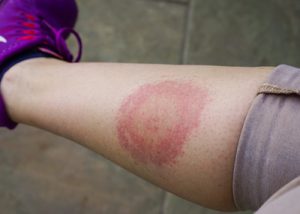 If fever, flu-like symptoms with headache and/or aching limbs or skin symptoms such as the so-called wandering redness occur after a tick bite, then the family doctor should be consulted. Antibodies against the Borrelia bacteria can be detected by blood test; however, at the earliest about three weeks after the tick bite.
If fever, flu-like symptoms with headache and/or aching limbs or skin symptoms such as the so-called wandering redness occur after a tick bite, then the family doctor should be consulted. Antibodies against the Borrelia bacteria can be detected by blood test; however, at the earliest about three weeks after the tick bite.
The incubation period, i.e. the time between the sting and the onset of the first signs of the disease, varies greatly. Sometimes only a few days pass, sometimes weeks to months until symptoms appear. Particularly treacherous: In chronic Lyme disease, unfortunately, symptoms often appear even years later. In other words, at a time when those affected can hardly – if ever – remember a tick bite. Even the therapists then usually only think of a past Borrelia infection after countless unsuccessful therapy attempts.

Every person is unique!
Our experienced team will be happy to advise you in detail and free of charge on all matters relating to your health.
Conventional and naturopathic therapeutic approaches
Conventional medicine uses various antibiotics – in tablet form or by infusion. The naturopathic treatment approach can support antibiotic administration. Since antibiotics usually cannot distinguish between desired and desirable bacteria, they often weaken the intestinal flora and thus our immune system. Here, vital mushrooms with their prebiotic and intestinal flora protecting properties can be a good complement to conventional medical therapy.
The situation is different in chronic Lyme disease, where antibiotics are usually no longer successful. Chronic Lyme disease is more of a chronic inflammatory event that is addressed with anti-inflammatory, immune balancing, and general strengthening measures. Since large portions of our immune system are localized in the gut, it makes sense to start here. The body’s defenses can be significantly strengthened with intestinal rehabilitation, possibly a change in diet to an anti-inflammatory, vital and fiber-rich diet and the targeted intake of medicinal or vital mushroom powder. The aim of this therapeutic approach is to reduce the inflammation caused by the Borrelia bacteria as best as possible and at the same time to optimally support the immune defense.
Phytotherapy - herbal medicine
Numerous plant species have already been tested in vitro – i.e. in the Petri dish – for their effect against Borrelia. The results are encouraging and in some cases show quite promising active properties of individual plants. The findings obtained cannot simply be transferred one-to-one to the effect in the human body. Nevertheless, it is beneficial to use plants and herbs such as frankincense, turmeric, Cistus incanus or Artemisia annua to accompany therapy.

Every person is unique!
Our experienced team will be happy to advise you in detail and free of charge on all matters relating to your health.
Mycotherapy: Important vital mushrooms for Lyme disease
Various medicinal or vital mushrooms can support the organism of the affected person very well. Optimal is the application of the vital mushrooms as mushroom powder from the whole mushroom, because only here all valuable and active ingredients are also contained in the powder. Through the regulation and strengthening of the immune system and the associated promotion of the self-healing powers, vital mushrooms also enable significant relief in the case of a chronified complaint. In the best case, they can even make the symptoms disappear completely. The quality of life is therefore significantly improved; fatigue and concentration difficulties are reduced.
Coriolus
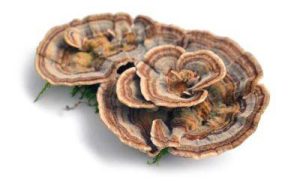 The selection of vital mushrooms depends on the individual symptoms. To support the immune system, Coriolus is the first choice. This vital mushroom has also generally proven to improve our defenses against bacterial and viral infections. This is also extremely significant, because ticks can transmit other pathogens in addition to Borrelia.
The selection of vital mushrooms depends on the individual symptoms. To support the immune system, Coriolus is the first choice. This vital mushroom has also generally proven to improve our defenses against bacterial and viral infections. This is also extremely significant, because ticks can transmit other pathogens in addition to Borrelia.
Reishi
A good complement to Coriolus is the vital mushroom Reishi, which has proven itself, among other things, in all inflammatory processes.
Hericium
Depending on the symptoms of the affected person, it is additionally recommended to take Hericium and Cordyceps. Hericium is commonly used naturopathically when the nervous system is affected.
Cordyceps
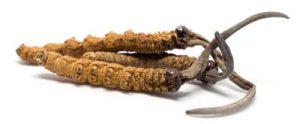 Cordyceps, in turn, has a good effect when people suffer from symptoms of exhaustion.
Cordyceps, in turn, has a good effect when people suffer from symptoms of exhaustion.

Every person is unique!
Our experienced team will be happy to advise you in detail and free of charge on all matters relating to your health.
What should I look for when choosing vital mushrooms?
Even though some of the specified vital mushrooms are considered edible mushrooms, to achieve a therapeutic effect, the regular intake of mushrooms in the form of mushroom powder is necessary. It is important here that the mushroom powder is gently cooked at max. 40 ° C has been dried and also contains all the components of the fungus.
Be sure to look for organic quality when researching your provider of choice! Mushrooms absorb – like a sponge – toxins from the soil, which are then passed on to the consumer. Only organic quality mushroom powder excludes this undesirable effect.
In order that the mushroom powder is also protected from contamination and mold, it is recommended to buy mushroom powder in capsules.
DO YOU HAVE ANY QUESTIONS?
We will gladly take time for you. In our free consultation, we answer all your health questions individually and personally. We are looking forward to meeting you!
